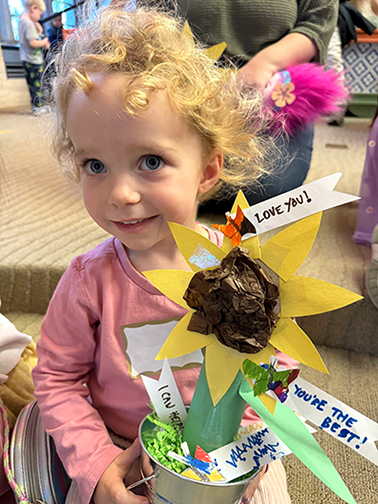 What could be better then a big brilliant sunflower? Why, a sunflower that also shares good thoughts and positive messages with everyone! It’s a colorful craft project with a lot of heart, much like the author of this very special story time book.
What could be better then a big brilliant sunflower? Why, a sunflower that also shares good thoughts and positive messages with everyone! It’s a colorful craft project with a lot of heart, much like the author of this very special story time book.
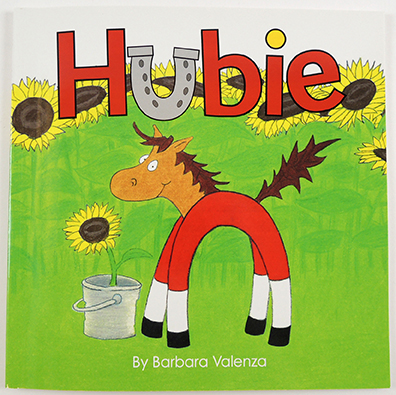
We read Hubie by Barbara Valenza (Potato Publishing, 2021). Hubie is an unhappy horse who seems to attract bad feelings and problems. Overwhelmed, he shouts for help…and help arrives! A brilliant creature kindly explains that Hubie is a magnet, attracting both positives and negatives. She encourages him to learn from the negatives, and focus on the positives. Taking her lessons to heart, Hubie transforms his life from misery to joy.
Barbara Valenza has been featured on our blog before! Take a look at the wonderful story time and interview for her picture book, Little Lovedog’s Long Walk Home.
You’ll need:
- 1 paper towel tube
- 1 small box, bucket, cup, or flower pot
- Construction paper
- A butterfly template, printed on 8.5″ x 11″ card stock
- Scissors, tape, and glue for construction
- Markers for decorating
Our sunflower construction was very basic…a paper towel tube served as the stalk, and then we attached construction paper petals and leaves. If you’d like to add a little texture, use cardboard to create the sunflower’s face, then glue brown tissue paper fringes on it:
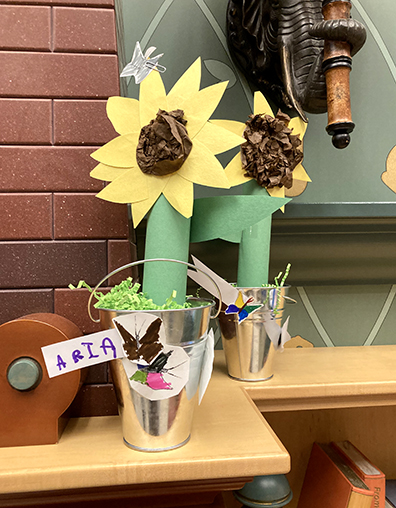 In the story, Hubie the Horse uses a dented bucket for his sunflower, so we snagged these cute mini buckets on Amazon. But a box, paper cup, or flower pot works just as well. We also added green crinkle paper around the sunflower’s base to steady the stalk. Now for the message butterflies!
In the story, Hubie the Horse uses a dented bucket for his sunflower, so we snagged these cute mini buckets on Amazon. But a box, paper cup, or flower pot works just as well. We also added green crinkle paper around the sunflower’s base to steady the stalk. Now for the message butterflies!
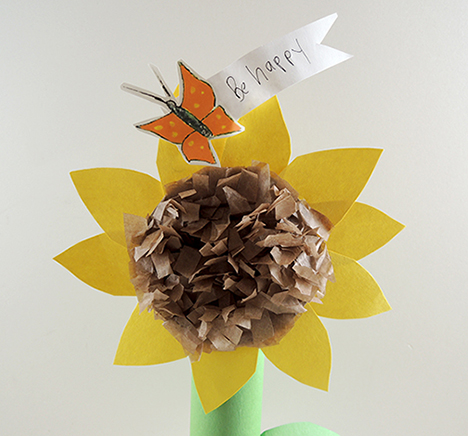 Color and cut the butterflies from the template, then add a tag with a positive message on it. You can attach the message butterflies directly to the sunflower, or you can do what we did and turn them into magnets! Our magnetic butterflies attached to the metal buckets, but we also slipped paperclips on the petals for the butterflies to rest on. Gift a message butterfly to friends and family, and they can proudly display them on their fridges!
Color and cut the butterflies from the template, then add a tag with a positive message on it. You can attach the message butterflies directly to the sunflower, or you can do what we did and turn them into magnets! Our magnetic butterflies attached to the metal buckets, but we also slipped paperclips on the petals for the butterflies to rest on. Gift a message butterfly to friends and family, and they can proudly display them on their fridges!
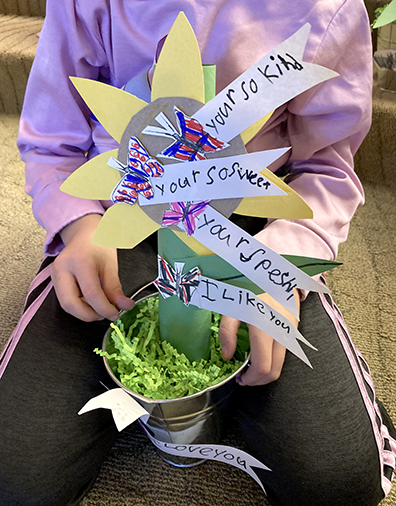
We also had a special surprise for our story time kids. Barbara Valenza famously sewed stuffed animals of her book characters (check out her Little Lovedog dachshund). Well, here’s Hubie, her awesome horseshoe magnet horse:
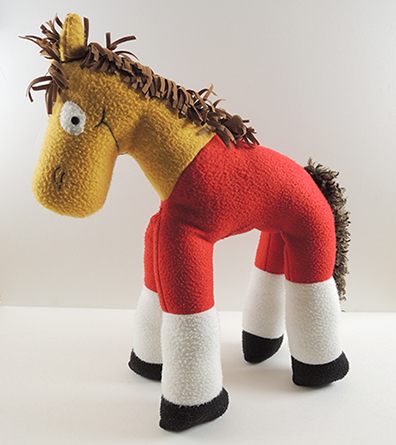 As a nod to her marvelous sewing skills, we had a drawing for a GIANT stuffed horse at story time. Here’s our happy winner…she was quite enamored, and her Dad emailed me later and shared that she insisted it sleep next to her that night.
As a nod to her marvelous sewing skills, we had a drawing for a GIANT stuffed horse at story time. Here’s our happy winner…she was quite enamored, and her Dad emailed me later and shared that she insisted it sleep next to her that night.
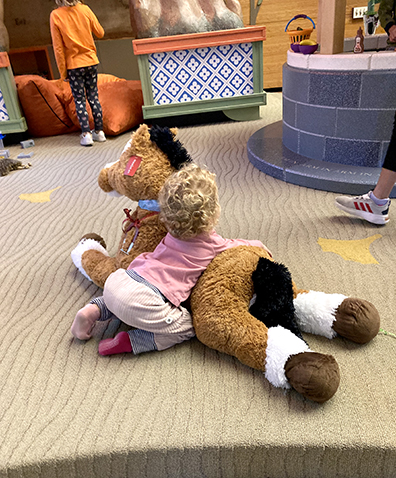 This story time was full of love, laughter, positivity, joy, and delight. This was very intentional, as it was also a celebration of Barbara herself, who passed in February 2024. Hubie has a special place in my heart, and I was extraordinarily honored to share her final book with our community.
This story time was full of love, laughter, positivity, joy, and delight. This was very intentional, as it was also a celebration of Barbara herself, who passed in February 2024. Hubie has a special place in my heart, and I was extraordinarily honored to share her final book with our community.
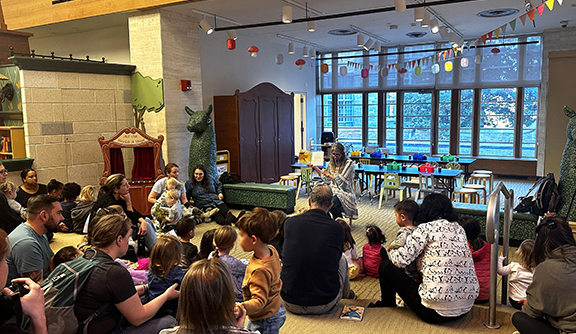 One last magical thing. Barbara’s husband Mark came to the event and brought copies of Hubie for every family! It was incredibly generous, and I very much want to thank him for coming and celebrating with us. Kids weren’t even waiting until they left the library to enjoy the story of sweet Hubie the Horse.
One last magical thing. Barbara’s husband Mark came to the event and brought copies of Hubie for every family! It was incredibly generous, and I very much want to thank him for coming and celebrating with us. Kids weren’t even waiting until they left the library to enjoy the story of sweet Hubie the Horse.
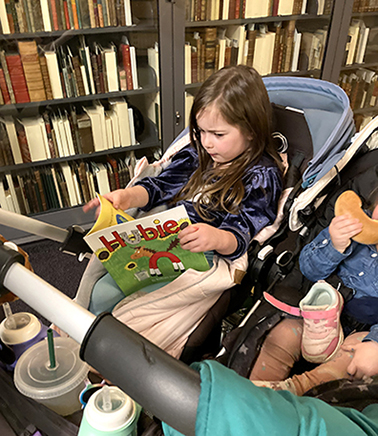
 Have a reluctant reader who might appreciate good race? This simple project will get them raring to read letters and words with the assistance of their own personal reading robot! Built out of things in your home or office, it’s low tech, but high levels of F-U-N!
Have a reluctant reader who might appreciate good race? This simple project will get them raring to read letters and words with the assistance of their own personal reading robot! Built out of things in your home or office, it’s low tech, but high levels of F-U-N!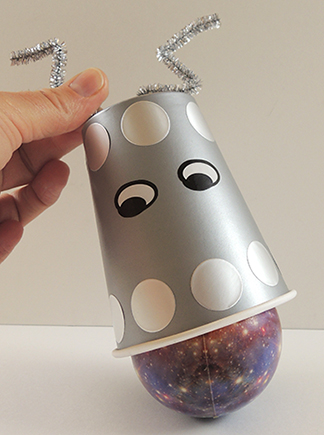 Next, write alphabet letters on Post-it notes and stick them to a tabletop. Have the reader and their robot sit on the opposite side of the table. As you call out the letter, they can slide and release their robot towards the proper Post-it!
Next, write alphabet letters on Post-it notes and stick them to a tabletop. Have the reader and their robot sit on the opposite side of the table. As you call out the letter, they can slide and release their robot towards the proper Post-it!

 Our unicorn is the stick horse we designed for this
Our unicorn is the stick horse we designed for this 

 What could be better then a big brilliant sunflower? Why, a sunflower that also shares good thoughts and positive messages with everyone! It’s a colorful craft project with a lot of heart, much like the author of this very special story time book.
What could be better then a big brilliant sunflower? Why, a sunflower that also shares good thoughts and positive messages with everyone! It’s a colorful craft project with a lot of heart, much like the author of this very special story time book.
 In the story, Hubie the Horse uses a dented bucket for his sunflower, so we snagged these cute mini buckets on Amazon. But a box, paper cup, or flower pot works just as well. We also added green crinkle paper around the sunflower’s base to steady the stalk. Now for the message butterflies!
In the story, Hubie the Horse uses a dented bucket for his sunflower, so we snagged these cute mini buckets on Amazon. But a box, paper cup, or flower pot works just as well. We also added green crinkle paper around the sunflower’s base to steady the stalk. Now for the message butterflies! Color and cut the butterflies from the template, then add a tag with a positive message on it. You can attach the message butterflies directly to the sunflower, or you can do what we did and turn them into magnets! Our magnetic butterflies attached to the metal buckets, but we also slipped paperclips on the petals for the butterflies to rest on. Gift a message butterfly to friends and family, and they can proudly display them on their fridges!
Color and cut the butterflies from the template, then add a tag with a positive message on it. You can attach the message butterflies directly to the sunflower, or you can do what we did and turn them into magnets! Our magnetic butterflies attached to the metal buckets, but we also slipped paperclips on the petals for the butterflies to rest on. Gift a message butterfly to friends and family, and they can proudly display them on their fridges!
 As a nod to her marvelous sewing skills, we had a drawing for a GIANT stuffed horse at story time. Here’s our happy winner…she was quite enamored, and her Dad emailed me later and shared that she insisted it sleep next to her that night.
As a nod to her marvelous sewing skills, we had a drawing for a GIANT stuffed horse at story time. Here’s our happy winner…she was quite enamored, and her Dad emailed me later and shared that she insisted it sleep next to her that night. This story time was full of love, laughter, positivity, joy, and delight. This was very intentional, as it was also a celebration of Barbara herself, who passed in February 2024. Hubie has a special place in my heart, and I was extraordinarily honored to share her final book with our community.
This story time was full of love, laughter, positivity, joy, and delight. This was very intentional, as it was also a celebration of Barbara herself, who passed in February 2024. Hubie has a special place in my heart, and I was extraordinarily honored to share her final book with our community. One last magical thing. Barbara’s husband Mark came to the event and brought copies of Hubie for every family! It was incredibly generous, and I very much want to thank him for coming and celebrating with us. Kids weren’t even waiting until they left the library to enjoy the story of sweet Hubie the Horse.
One last magical thing. Barbara’s husband Mark came to the event and brought copies of Hubie for every family! It was incredibly generous, and I very much want to thank him for coming and celebrating with us. Kids weren’t even waiting until they left the library to enjoy the story of sweet Hubie the Horse.